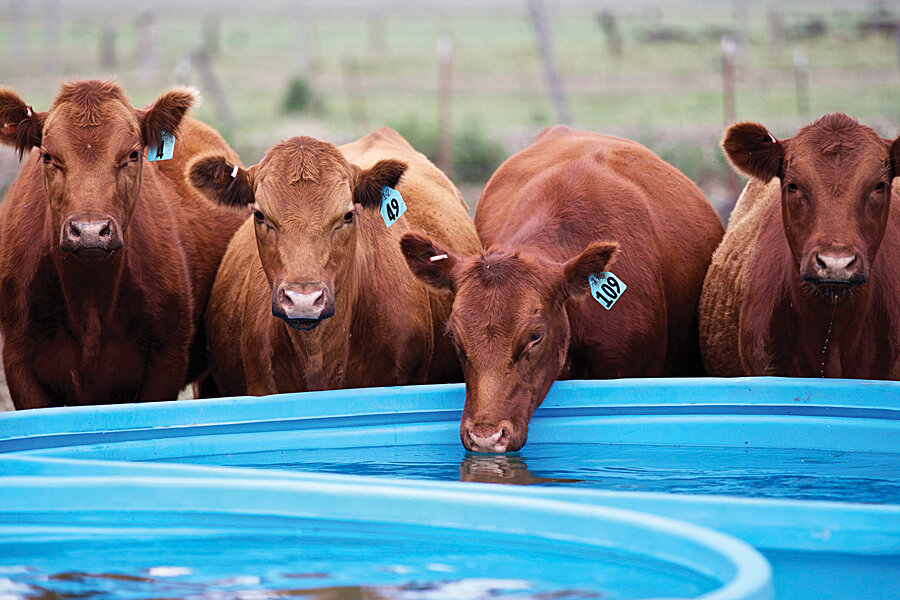Good Reads: From lab-grown meat, to solar LED lamps, to Algebra II reconsidered
Loading...
It’s no secret that Americans like to eat meat. And despite the fact that a growing number of scientists, doctors, environmentalists, and animal rights activists have warned that the overconsumption of meat is not healthy, sustainable, or good for the environment, the demand for meat hasn’t let up (bacon cupcake fad, I’m looking at you). Fun fact: The average person in the United States eats about 270 pounds of meat a year, reports Laura June in The Verge.
But if Americans can’t be convinced to go meatless in an effort to be gentler on the environment or kinder to animals, or to reach greenhouse-gas emission goals, perhaps they can change the way they get their meat, suggests Ms. June.
She writes about a process that is poised to shift the discussion on the environmental, health, and ethical issues surrounding farm animals: meat grown in a lab using stem cells. By using meat produced in a sterile environment, no animals are harmed and no land for grazing is needed. People who have tried a lab meat burger say it is tasty, healthy (zero fat), and indistinguishable from one made of animal meat. And lab-grown meat could be ready for grocery stores and restaurants within the next couple of decades.
Escape from Thailand
When you think of Thailand, you might think of the beaches, the sunshine, and ubiquitous smiles. But journalist Erika Fry shares in the Columbia Journalism Review the gripping story of her narrow escape from languishing for years in a Thai jail after she wrote what seemed to be a straightforward story in the Bangkok Post. She had reported that a Thai official had been accused of plagiarizing his doctoral dissertation on organic asparagus. Although the evidence against him was overwhelming, he, in turn, opened a defamation case against her. What would have been an open-and-shut case in the US in Ms. Fry’s favor, turned into a day in jail, a number of secret meetings, subterfuge, and a lesson in Thailand’s draconian defamation laws and how its justice system is routinely manipulated by people in positions of power and influence.
Kazakhstan as an antiterror investment
This summer President Obama said he would rethink his opposition to the US military involvement in Syria if the regime there were to use its stockpile of chemical and biological weapons. Now, as the world determines how to respond to the use of chemical weapons in Syria, Alex Pasternack takes this as a timely moment to point out in Vice magazine that the Pentagon is pumping hundreds of millions of dollars into its own biological warfare program: Kazakhstan’s new Central Reference Laboratory. “When it opens in September 2015, the $102-million project laboratory is meant to serve as a Central Asian way station for a global war on dangerous disease,” writes Mr. Pasternack.
Not all the nearby residents are thrilled to have a lethal disease laboratory in their neighborhood. But a number of decaying Soviet-era buildings, where the USSR once “kept some of its finest potential bioweapons,” are being upgraded to withstand all the seismic activity in the region, as well as updated security measures. It’s all an effort to develop scientific expertise on biological weapons, build relationships, and keep them from getting into the wrong hands in a key regional location.
Let there be good light
About two hours southeast of Nairobi, Kenya, where many live in mud-walled, grass-roofed homes and eke out a living raising goats and growing crops like kale and maize, an unlikely economic transformation is taking place. David Talbot of MIT Technology Review reports on Evans Wadongo and his idea to bring solar-charged LED lanterns to remote villages lit by dim kerosene lamps. But he knew the new lamps wouldn’t succeed unless they had villager investment. So the lanterns are made in “local workshops with scrap metal and off-the-shelf photovoltaic panels, batteries, and LEDs.” Each is stamped with the words Mwanga Bora (Swahili for “Good Light”). Villagers have been using the money they save on kerosene to launch their own local enterprises.
The case against Algebra II
Think back to your high school days. Do you remember sitting at your kitchen table hunched over Algebra II homework that you just didn’t get? A well-intentioned math teacher likely told you that the problem solving required in Algebra II would come in handy and you’d be glad you had persevered.
That might not actually be true. In fact, it turns out that perfectly reasonable lovers and teachers of mathematics have long believed Algebra II isn’t for everyone and shouldn’t be forced on children, but rather treated like an elective course. But this is a story that doesn’t get told often: It’s too sensitive a topic, writes Nicholson Baker in Harper’s magazine.
Traditional thinking goes, writes Mr. Baker, that requiring students to slog through Algebra II as a prerequisite for college admissions develops reasoning skills and produces scientists. Except it doesn’t. The US appears to have fewer home-grown scientists now than when Algebra II wasn’t required. “By 1950, at a time when only a quarter of American high school students were taking algebra, the nation’s technological prowess was the envy of the planet,” writes Baker.






